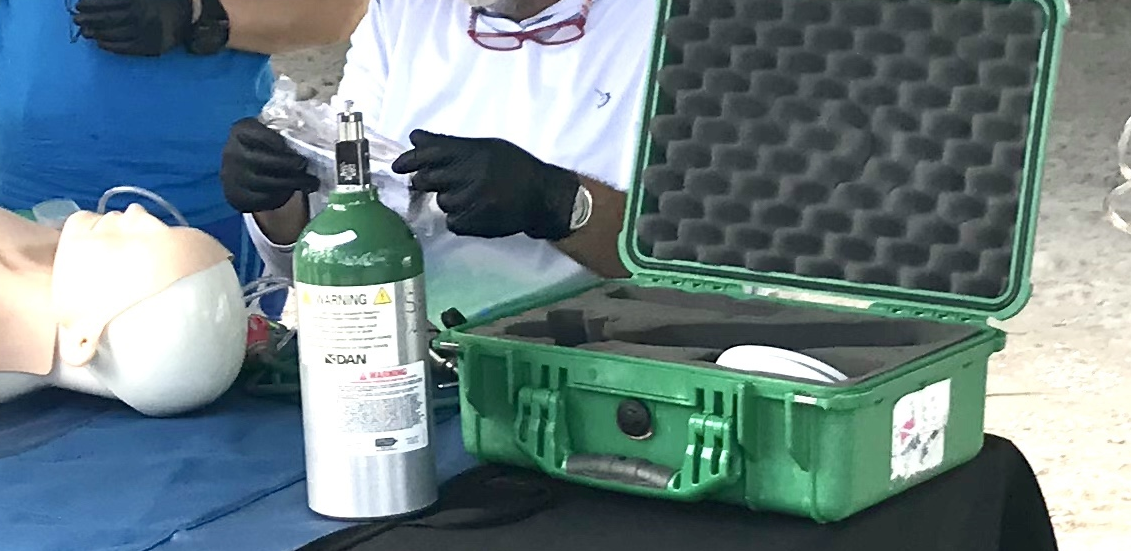Dive Boat Safety 101: Why Dive Boats Carry an Oxygen Kit

The rhythmic hum of the engine, the thrill of anticipation as you gear up, the first glimpse of vibrant coral as you descend – there’s nothing quite like the magic of a scuba dive. But in this underwater world, unexpected situations can arise. That’s why every responsible dive boat carries a silent guardian: the oxygen kit.
Scuba divers push our bodies harder than most people. Not just the fact that we strap 40+ pounds of gear to our backs and jump off a perfectly good boat, but we also put stress on our bodies as we dive deeper and explore. As with everything in life, things can go wrong. Decompression sickness (DCS), when nitrogen bubbles form in the bloodstream, or arterial gas embolism (AGE), caused by air bubbles entering the bloodstream, are two potentially life-threatening conditions that can happen to divers. This is where oxygen kits come in.
Breathe Easy, Dive Safe, an Oxygen Kit is on board
To put it simply, breathing pure oxygen significantly aids in dissolving nitrogen bubbles that may have formed when you ascend too fast or stay down past your “No Deco” limit. Breathing regular air means you are breathing in around 78% nitrogen, making the process of off-gassing nitrogen even slower. When you breathe pure oxygen, you aren’t adding to the nitrogen load in your tissues. This prevents the growth of Nitrogen bubbles and the potential tissue damage they may cause. Giving oxygen to an injured diver also improves the oxygenation of vital tissues, supporting the healing process. While oxygen is not a cure-all, oxygen therapy can buy precious time until a diver reaches proper medical care. In almost all cases, providing oxygen will not harm and it will usually help speed the healing process.
Learn How to Use an Oxygen Kit
Responsible dive boat operators equip their boats with a First Aid kit and an Oxygen kit. On the dive boats that I dive on regularly here in Palm Beach County, Florida, all boat staff are certified in the administration of oxygen. This training includes:
- How to properly and quickly assemble the kit
- What masks are appropriate in different circumstances
- How to include O2 in other rescue operations
All of these skills and more are covered in most Oxygen Administration certifications.
While dive boat staff are trained in oxygen administration, your understanding of how to use an oxygen kit can be invaluable. Consider taking a course on emergency oxygen administration to equip yourself with the skills to assist yourself or a buddy should the need arise. Even if there are trained and experienced staff on board to handle the emergency, knowing what is going on and what needs to be done means that you will be a valuable asset to the boat staff.
Know Before You Go
Whenever you board a dive boat, there are a few questions you need answered before the boat leaves the dock. Here in Palm Beach County, they are almost always covered in “The Captian’s Briefing”. (Members of our mailing list for new scuba divers will recognize the Captian’s Briefing as one of the 3 times you shut up, sit down, and listen on a dive boat.)
- Do you have a First Aid kit on board?
- Do you have an O2 kit on board?
- When was the last time the O2 kit was checked?
- Which staff are Rescue and O2 trained?
If you don’t get satisfactory answers to these questions, consider packing it up and getting off the boat before it leaves the dock. Additionally, sarcastic answers to these 4 questions should be a red flag that should give you pause to consider whether you want to dive with this crew or not.
An Oxygen Kit on Shore Dives
While our focus so far has been O2 kits on dive boats, they are equally important on shore dives. Before you enter the water check to make sure that a functional O2 is nearby. When we dive at the beautiful Blue Heron Bridge, we know that the lifeguards on duty have an oxygen kit and are trained in its use.
For those times when we are diving outside of lifeguard hours, especially if teaching, we will sign out one of the O2 kits from the dive center.
Wrap Up
So, the next time you board a dive boat, give a brief thought to the supplies needed in case something goes wrong. Nobody wants to dwell on the negative, but prudent divers do give the topic more than a passing thought. The red first aid kit and the green oxygen kit are more than just decorations on a dive boat. They are there for your safety. Making sure they are available and in good working order should not be annoying to the crew, they should be happy to answer your questions.
These tools, together with responsible diving practices will give you the peace of mind to dive confidently. Diving confidently allows you to transform every dive into an unforgettable adventure.